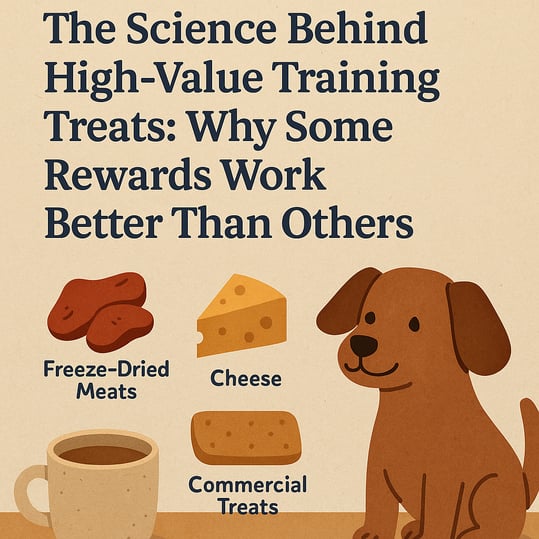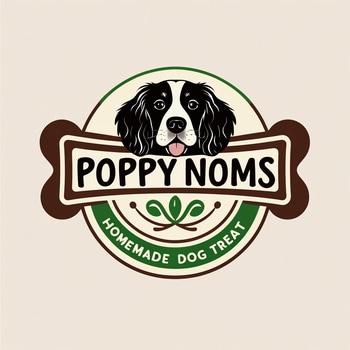The Science Behind High-Value Training Treats: Why Some Rewards Work Better Than Others
6/26/20253 min read


Pour yourself a cuppa and let’s dig into what really makes your dog tick during training.
When it comes to training your dog, there’s one secret ingredient that makes everything run smoother: motivation. And no, we’re not talking about long speeches or doggy TED Talks — we’re talking about treats.
But not just any treats. We’re talking about high-value dog treats — the kind your dog would do backflips for. You’ve probably heard trainers talk about them, but what actually makes a treat “high-value”? Why does one dog go wild for freeze-dried liver while another would sell their soul for a crumb of cheddar?
Let’s get into the science and sniff out the best dog training treats for your four-legged friend.
🧠 Canine Motivation: What Makes a Treat “High-Value”?
Dogs, like people, are motivated by what they love most. In training, high-value rewards are those that spark an instant “YES!” in your dog’s brain — triggering a rush of dopamine, the feel-good chemical that says, “That was worth it — do it again!”
This is where high-value dog treats shine. They’re the treats your dog doesn’t get all the time and that smell (and taste) irresistible.
Think of it this way:
Kibble = their daily wage
Low-value treats = minimum wage
High-value treats = bonus + pizza party + employee of the month
Your job? Figure out what your dog thinks is pizza.
🥩 Freeze-Dried Meats vs Cheese vs Commercial Treats
Let’s break down the most common types of training rewards and how they stack up in terms of science-backed motivation.
🔹 Freeze-Dried Meats (like liver or salmon)
Pros: Smelly, rich in protein, and oh-so-enticing for most dogs.
Cons: Can be crumbly and a bit pricey, but you don’t need a lot.
Science says: Dogs are scavengers by nature — meat speaks to their primal side.
Best for: Distracting environments, tricky commands, or recall training.
🔸 Cheese (yes, the fridge-obsession is real)
Pros: Soft, rich in fat, easy to break into tiny pieces.
Cons: Some dogs are sensitive to dairy. Go easy on portions.
Science says: High-fat foods trigger intense reward responses in the brain.
Best for: Short training sessions or working through stubborn behaviors.
🔹 Commercial Treats
Pros: Convenient, shelf-stable, and designed to appeal to dogs.
Cons: Can vary wildly in quality — check for junky fillers.
Science says: Many brands are designed with palatability enhancers for maximum appeal.
Best for: Everyday training or casual reinforcement.
⏱ Timing Is Everything
Even the best dog training treats won’t work if you mistime the reward. Dogs live in the now, so a treat given even 3–5 seconds too late may not reinforce the behavior you wanted.
Pro tip: Keep your treats handy, break them into tiny bits, and mark the moment your dog gets it right. Use a clicker or a verbal marker like “yes!” immediately, then follow with the treat.
📏 Size Matters (But Smaller is Better)
You don’t need to hand over a whole chunk of sausage every time your dog sits. The best treats are:
Small (pea-sized)
Soft and quick to chew
Smelly (to grab attention fast)
This keeps your dog engaged without filling them up too quickly — because no one trains well with a food coma.
🐕 How to Find Your Dog’s Top Motivators
Every dog is different — some would leap through hoops for tuna, others go gaga for bits of boiled chicken. So how do you find out what makes your dog tick?
Try a treat test:
Grab 3–5 different treat options.
Offer them one by one (no commands, just see what gets the biggest reaction).
Observe which one gets your dog the most excited (tail wags, eager sniffs, sitting automatically).
That’s your high-value treat. Use it wisely — save it for the big stuff like recall, loose leash walking, or when you’re training in distracting places like parks or busy streets.
🐾 Science-Based Training is On the Rise (and Your Dog Thanks You)
Modern dog training is all about positive reinforcement — rewarding the behaviors we do want instead of punishing the ones we don’t. And treats play a starring role.
Using rewards that actually motivate your dog builds trust, speeds up learning, and makes training fun for both of you. Plus, it’s backed by decades of research in animal behavior.
☕ Final Thoughts (Before You Top Up Your Tea)
Training doesn’t have to be a battle of wills. With the right motivation — especially the best dog training treats tailored to your pup — you’ll see just how eager your dog is to learn.
Remember:
Know what motivates your dog
Use high-value treats for challenging tasks
Keep them small, smelly, and well-timed
And most of all, enjoy the journey together. There’s nothing better than seeing your dog’s tail wag with pride when they get it right.
P.S. Want some treat ideas or homemade recipes your dog will adore? Stick around — we’ve got plenty more where that came from. 🐶💛
